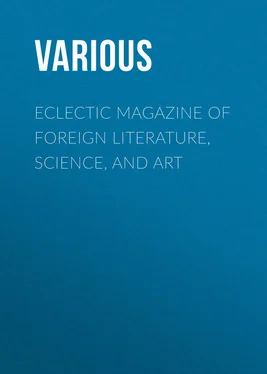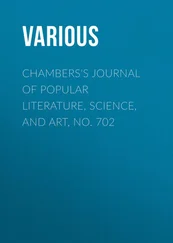Various - Eclectic Magazine of Foreign Literature, Science, and Art
Здесь есть возможность читать онлайн «Various - Eclectic Magazine of Foreign Literature, Science, and Art» — ознакомительный отрывок электронной книги совершенно бесплатно, а после прочтения отрывка купить полную версию. В некоторых случаях можно слушать аудио, скачать через торрент в формате fb2 и присутствует краткое содержание. Жанр: foreign_home, на английском языке. Описание произведения, (предисловие) а так же отзывы посетителей доступны на портале библиотеки ЛибКат.
- Название:Eclectic Magazine of Foreign Literature, Science, and Art
- Автор:
- Жанр:
- Год:неизвестен
- ISBN:нет данных
- Рейтинг книги:4 / 5. Голосов: 1
-
Избранное:Добавить в избранное
- Отзывы:
-
Ваша оценка:
- 80
- 1
- 2
- 3
- 4
- 5
Eclectic Magazine of Foreign Literature, Science, and Art: краткое содержание, описание и аннотация
Предлагаем к чтению аннотацию, описание, краткое содержание или предисловие (зависит от того, что написал сам автор книги «Eclectic Magazine of Foreign Literature, Science, and Art»). Если вы не нашли необходимую информацию о книге — напишите в комментариях, мы постараемся отыскать её.
Eclectic Magazine of Foreign Literature, Science, and Art — читать онлайн ознакомительный отрывок
Ниже представлен текст книги, разбитый по страницам. Система сохранения места последней прочитанной страницы, позволяет с удобством читать онлайн бесплатно книгу «Eclectic Magazine of Foreign Literature, Science, and Art», без необходимости каждый раз заново искать на чём Вы остановились. Поставьте закладку, и сможете в любой момент перейти на страницу, на которой закончили чтение.
Интервал:
Закладка:
The Etnean observatory is the most elevated building in Europe. It stands at a height above the sea of 9,655 ft., or 1,483 ft. above the monastery of the Great St. Bernard. Its walls enclose the well-known “Casa Inglese,” where travellers were accustomed to spend the night before undertaking the final ascent of the cone, and occupy a site believed secure from the incursions of lava. Astronomical work is designed to be carried on there from June to September. For the Merz equatorial, 35 centimetres (13·8 inches) in aperture, which is facile primus of its instrumental equipment, a duplicate mounting has been provided at Catania, whither it will be removed during the winter months. The primary aim of the establishment is the study of the sun. Its great desirability for this purpose formed the theme of the representations from Signor Tacchini (then director of the observatory of Palermo, now of that of the Collegio Romano), which determined the Italian government upon trying the experiment. But we hear with pleasure that stellar spectroscopy will also come in for a large share of attention. The privilege of observation from the summit of Etna will not be enjoyed exclusively by the local staff. The Municipality of Catania who have borne their share in the expense of the undertaking, generously propose to give it somewhat of an international character, by providing accommodation for any foreign astronomers who may desire to enjoy a respite from the hampering conditions of low-level star-gazing. We cannot doubt that such exceptional facilities will be turned to the best account.
Eight years have now passed since General de Nansonty, aided by the engineer Vaussenat, established himself for the winter on the top of the Pic du Midi. Zeal for the promotion of weather-knowledge was the impelling motive of this adventure, which included, amongst other rude incidents, a snow-siege of little less than six months. It resulted in crowning one of the highest crests of the Pyrenees with a permanent meteorological observatory opened for work in 1881. It is now designed to render the station available for astronomical purposes as well.
The important tasks in progress at the Paris observatory have of late been singularly impeded by bad weather. During the latter half of 1882 scarcely four or five good nights per month were secured, and in December these were reduced to two. 25 25 Report of the Paris Observatory, “Astronomical Register,” Oct. 1883; and “Observatory,” No. 75.
Moreover, M. Thollon, who, according to his custom, arrived from Nice in June for the summer’s work, returned thither in September without having found the opportunity of making one single spectroscopic observation. Yet within easy and immediate reach was a post, already in scientific occupation, where as General de Nansonty reported, ordinary print was legible by the radiance of the milky way and zodiacal light alone, and fifteen or sixteen Pleiades could be counted with the naked eye. At length Admiral Mouchez, the energetic director of the Paris observatory, convinced of the urgent need of an adjunct establishment under less sulky skies, issued to MM. Thollon and Trépied a commission of inquiry into telescopic possibilities on the Pic du Midi. Their stay lasted from August 17th, to September 22d, 1883, and their experiences were summarised in a note (preliminary to a detailed report) published in the “Comptes Rendus” for October 16th, glowing with a certain technical enthusiasm difficult to be conveyed to those who have never strained their eyes to catch the vanishing gleam of a “chromospheric line” through a “milky” sky, and dim and tremulous air. The definition, they declared, was simply marvellous. Not even in Upper Egypt had they seen anything like it. The sun stood out, clean-cut and vivid, on a dark blue sky, and so slight were the traces of diffusion, that, for observations at his edge the conditions approached those of a total eclipse. These advantages are forcibly illustrated by the statement that, instead of eight lines ordinarily visible in the entire spectrum of the chromosphere, more than thirty revealed themselves in the orange and green parts of it alone (Dto. F)! A fact still more remarkable is that prominences were actually seen, and their forms distinguished, though foreshortened and faint, on the very disc of the sun itself – and this not merely by such glimmering views as had previously, at especially favorable moments, tantalised the sight of Young and Tacchini, but steadily and with certainty. We are further told that, on the mornings of September 19th and 20th, Venus was discerned, without aid from glasses, within two degrees of the sun.
These extraordinary facilities of vision disappeared, indeed, as, with the advance of day, the slopes of the mountain became heated and set the thin air quivering; but were reproduced at night in the tranquil splendor of moon and stars.
The expediency of using such opportunities was obvious; and it has accordingly been determined to erect a good equatorial in this tempting situation, elevated 9,375 feet above the troubles of the nether air. The expense incurred will be trifling; no special staff will be needed; the post will simply constitute a dependency of the Paris establishment, where astronomers thrown out of work by the malice of the elements may find a refuge from enforced idleness, as well as, possibly, unlooked-for openings to distinction.
We must now ask our readers to accompany us in one more brief flight across the Atlantic. After a successful observation of the late transit of Venus at Jamaica, Dr. Copeland, the chief astronomer of Lord Crawford’s observatory at Dun Echt, took advantage of the railway which now crosses the Western Andes at an elevation of 14,666 feet, to make a high-level tour of exploration in the interests of science. Some of the results communicated by him to the British Association at Southport last year, and published, with more detail, in the astronomical journal “Copernicus,” are extremely suggestive. At La Paz, in Bolivia, 12,050 feet above the sea, a naked-eye sketch of the immemorially familiar star-groups in Taurus, made in full moonlight , showed seventeen Hyades (two more than are given in Argelander’s “Uranometria Nova”) and ten Pleiades. Now ordinary eyes under ordinary circumstances see six, or at most seven, stars in the latter cluster. Hipparchus censured Aratus – who took his facts on trust from Eudoxus – for stating the lesser number, on the ground that, in serene weather, and in the absence of the moon, a seventh was discernible. 26 26 Hipp. ad Phaenomena, lib. i. cap. xiv.
On the other hand, several of the ancients reckoned nine Pleiades, and we are assured that Moestlin, the worthy preceptor of Kepler, was able to detect, under the little propitious skies of Wurtemberg, no less than fourteen. 27 27 Cosmos, vol. iii. p. 272 note .
An instance of keensightedness but slightly inferior is afforded by a contemporary American observer: Mr. Henry Carvil Lewis, of Germantown, Pennsylvania, frequently perceives twelve of this interesting sidereal community. 28 28 Am. Jour. of Science, vol. xx. p. 437.
The number of Pleiades counted is, then, without some acquaintance with the observer’s ordinary range of sight, a quite indeterminate criterion of atmospheric clearness; although we readily admit that Dr. Copeland’s detection of ten in the very front of a full moon gives an exalted idea of visual possibilities at La Paz.
During the season of tempestades – from the middle of December to the end of March – the weather in the Andes is simply abominable. Mr. Whymper describes everything as “bottled up in mist” after one brief bright hour in the early morning, and complains, writing from Quito, March 18th, 1880, 29 29 Nature, vol. xxiii. p. 19.
that his exertions had been left unrewarded by a single view from any one of the giant peaks scaled by him. Dr. Copeland adds a lamentable account – doubly lamentable to an astronomer in search of improved definition – of thunderstorms, torrential rains merging into snow or hail, overcast nocturnal skies, and “visible exhalations” from the drenched pampas. At Puno, however, towards the end of March, he succeeded in making some valuable observations, notwithstanding the detention – as contraband of war, apparently – of a large part of his apparatus. Puno is the terminal station on the Andes railway, and is situated at an altitude of 12,540 feet.
Интервал:
Закладка:
Похожие книги на «Eclectic Magazine of Foreign Literature, Science, and Art»
Представляем Вашему вниманию похожие книги на «Eclectic Magazine of Foreign Literature, Science, and Art» списком для выбора. Мы отобрали схожую по названию и смыслу литературу в надежде предоставить читателям больше вариантов отыскать новые, интересные, ещё непрочитанные произведения.
Обсуждение, отзывы о книге «Eclectic Magazine of Foreign Literature, Science, and Art» и просто собственные мнения читателей. Оставьте ваши комментарии, напишите, что Вы думаете о произведении, его смысле или главных героях. Укажите что конкретно понравилось, а что нет, и почему Вы так считаете.












